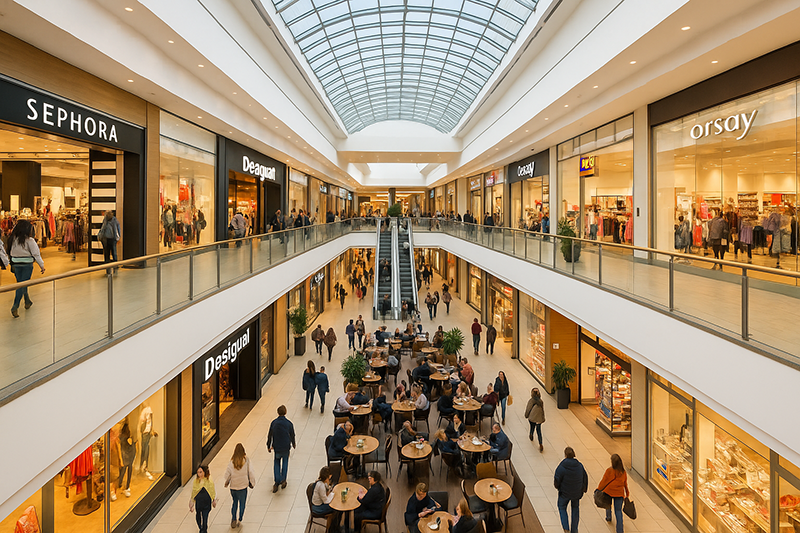Czech shopping centers show steady growth amid stable rents and improving consumer confidence
The latest Shopping Centre Index from real estate advisory firm CBRE shows that regional shopping centers in the Czech Republic performed steadily over the past year. This performance was largely supported by real wage growth and low inflation, which lifted consumer confidence and encouraged household spending. According to the Czech Statistical Office, real retail sales grew by 4.5% in 2024, indicating stable sector development. CBRE’s April 2025 survey of 1,200 shopping center visitors across the country confirmed these trends.
Visitor numbers at regional shopping centers rose by 1.2% year-on-year, although they remain 7.4% below pre-pandemic levels. Most people continue to visit these centers mainly for grocery shopping once or twice per week, and food courts remain popular for regular dining. Chain cafés like Starbucks, Costa Coffee, and McCafé are among the most frequently visited. Clothing, shoes, and accessories purchases are typically monthly activities. Notably, younger visitors aged 18 to 25 show a higher frequency of visits compared to older age groups.
Quarterly patterns showed a mixed picture in 2024: the first quarter saw a 3% increase in footfall, followed by a slight decline in the second quarter and stagnation in the third. However, a gradual recovery was visible from September onward, with 3% growth in the final quarter. Larger experience-focused shopping centers with entertainment and leisure options saw the strongest gains, while inner-city centers recorded a slight decline. For the youngest shoppers, dining and social activities have become nearly as important as shopping itself, whereas older visitors remain primarily motivated by shopping and special discounts.
Occupancy levels have remained consistently high, exceeding 96% by the end of last year. Fashion continues to take up the largest share of shopping center space at 36%, followed by specialty retail such as opticians, pharmacies, health and beauty stores, toys, and books at 14%, and sports goods at 12%. The household equipment and furniture category recorded the most notable expansion, growing by 6% in floor area and 5% in tenant numbers. Growth was also seen in health and beauty services, opticians, men’s fashion, and travel agencies, while leased space declined in footwear, women’s fashion, sports, and toys.
Retailers’ cost increases, which had been pronounced in previous years, moderated in 2024. Average rents in shopping centers rose by 3.5%, with the most significant increases seen in experience-based centers. Gastronomy tenants faced the highest rent increases at 10%, followed by electronics at 8%, while fashion rents rose only 1%, reflecting longer-term pressure in that segment. Among unit sizes, small spaces up to 50 m² saw the highest rent increases at 6%, largely due to demand from food, services, and health tenants, while larger units over 1,000 m² showed minimal rent growth.
Turnover in shopping centers rose by an average of nearly 4% year-on-year, surpassing inflation. Inner-city centers led the way, posting turnover growth of over 6%. Gastronomy was again a top-performing segment, with sales up 9%, particularly in fast food. Electronics sales rose 7%, and leisure activities (excluding cinemas) increased 6%. In the services segment, cosmetic services, such as barber shops and nail salons, were the fastest growing, with turnover up 5%.
Specialized retail, especially health and beauty products, continued to perform well, though the pace of turnover growth slowed. By contrast, fashion, accessories, and sports segments remained subdued in Czech shopping centers, despite a recovery in these categories across broader European markets. Fashion turnover declined 1% overall, mainly due to weaker performance in women’s and mixed fashion, though youth fashion rose by 3%. Online shopping remains a significant factor, with 45% of respondents making about 30% of their fashion purchases online, favoring platforms like H&M, Zalando, Lidl, and About You.
The sports segment saw a 2% decline in turnover, mainly because of weaker performance among large chains selling both apparel and equipment. However, smaller, specialized sports retailers focusing on fashion and accessories managed to achieve 1% growth.
Despite ongoing economic and political concerns, consumer sentiment has improved. According to CBRE’s survey, 35% of respondents expect their personal financial situation to improve over the next year. Younger people under 25 show the least concern about the economic environment, with 63% reporting no change in their shopping behavior. High resilience was also observed among consumers aged 26 to 34 and those over 65, while respondents aged 35 to 44 were the most likely to cut non-essential spending, often due to the costs of raising young children.
The first quarter of 2025 followed similar patterns to the end of 2024. Although seasonal effects, such as the timing of Easter, slightly influenced results, the data points to moderate and steady growth in the retail market. Shopping center footfall rose by around 3%, and turnover increased by an average of 2%, with January proving to be the strongest month at 4% growth. Vacancy rates remained effectively unchanged, holding near 4% in the first quarter.
Overall, the Czech shopping center sector appears to be in a stable phase, marked by modest growth, strong occupancy, and cautious optimism among both retailers and consumers.
Source: CBRE









